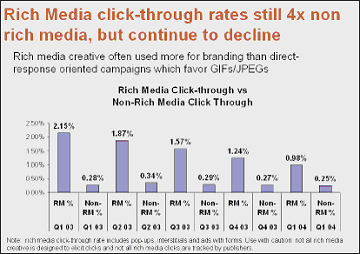Written by Jon Ostler – founder of First Rate
Would you use a weapon that fails to hits its target 99.75% of the time? If you are using banner ads to generate traffic then this is exactly what you are doing. The average click trough rate for banners tracked by DoubleClick is now <0.25% so you will get only 2.5 clicks for every 1,000 banners displayed (CPM).
This article is not an attack on the use of banner ads, but rather a review of the good, the bad, and the ugly methods being used by online advertisers in an attempt to generate traffic from banners (or blood from a stone).
It should be noted that banners are a valuable tool for marketers if used correctly and where the main desired outcome is primarily branding rather than direct conversions.
It is generally accepted that banners are a prohibitively expensive media if your expectation is traffic, conversions and a positive ROI. If however you want qualified visitors that convert into sales or enquiries there are other much more cost effective options.
So lets take a look at what’s hot and what’s not when it comes to returns…
- Not
- Carpet Bombing Banners
- Deception Banners
- Honey Trap Banners
- Full Frontal Attack Banners
- Ambush Banners
- Hot
- Do or Die (Performance Marketing)
- Smart Bomb (Contextual Advertsing)
Carpet Bombing Banners
Run of site or simplistic demographic placement of banners (display advertising) is the traditional model and is still very popular today even through it has failed for many years to generate traffic and has been the main contributor to consumer frustration and banner blindness. Homepage and run of site ads are used by those who wish everyone to see the advertising message over a short campaign period (such as a new product launch) or whose businesses model is based on extensive brand awareness advertising, or by those who don’t know any better!
Deception Banners
In an attempt to gain clicks and then present the marketing message, non descriptive ads are used that look intriguing or cool but do not actually describe the product, service or destination. Although these may increase click through rates the actual conversion rates remain low.
Honey Trap Banners
One of the most effective ways to generate traffic from banners is to offer prizes “Win a Play Station”. These banners generate traffic and even email registrations however unless the prize is closely aligned with your actual commercial offering conversion rates and ROI will be close to zero! Another popular honey trap is to offer a rich media banner where visitors can play space invaders or some other gimmick. Again in most cases these banners increase clicks but not conversions, but hey there’re cool!
Full Frontal Attack Banners
One of the main developments in banner advertising over the last couple of years has been pop-ups and Rich Media ads. Pop-ups are the number one method for driving your audience to distraction so much so that a whole industry has been created in popup blockers! So the advertisers have turned to floating ad technology like Eye Blaster where the ads are displayed within the page but over the content, this makes blocking more difficult but publishers have to be very careful not to frustrate visitors too much or they will abandon the publishers’ site rather than keep seeing the floating ads!
One other attempt to demand attention is to serve complete television ads in floating ads. Looks very cool and only takes up a few 100KB per ad displayed! The graph below shows that rich media ads novelty factor is running out fast and it appears banner blindness is spreading as people learn how to ignore these new formats.

Ambush Banners
One of the most effective ways around banner blindness is to have ads that don’t look like ads or ads that you only see when it’s too late to ignore! This is done in a number of ways;
- Inline Ads, smaller ads are placed inline with content so they are harder to ignore.
- Text Links, using text links is very effective as they don’t look like ads, load fast and are usually more descriptive than more creative banners.
- Syndicated content, proving content that in someway links back to the advertiser is very effective and akin to an infomercial. Again these are not seen as ads if the level of integration with the site is high.
Do or Die (Performance Marketing)
Performance marketing is an excellent approach where the publisher agrees to be paid on a performance basis, either on a cost per click, cost per action or commission basis. Many publishers and advertisers fail to utilise this approach generally due to a lack of understanding of the options available and the benefits to both parties. These programs offer both parties an opportunity to increase revenue and form long term partnerships.
If you would like to discuss how performance marketing could be used to promote your brand and generate qualified traffic please contact First Rate.
Smart Bomb (Contextual Marketing)
One of the hottest ways to place display advertising is via Google’s and Overtures contextual advertising networks. The Google network even supports the placement of GIF banners, tiles and towers. These networks perform so well in terms of brand impact, traffic generation and conversion because they use a “contextual” placement technology that only displays ads on pages that are directly related to the products and services being advertised.
For example if some one was selling tennis shoes then the ads would be displayed on pages about tennis or shoes but not rugby. Payment is on a pay per click basis and ads that do not generate a high click through rate are removed from the page.
If you would like to discuss how contextual advertising could be used to promote your brand and generate qualified traffic please contact First Rate.
